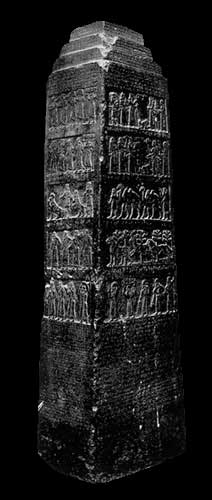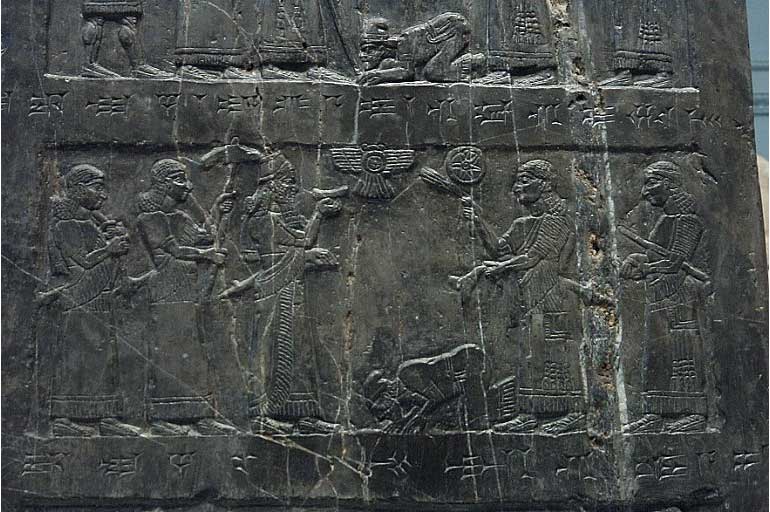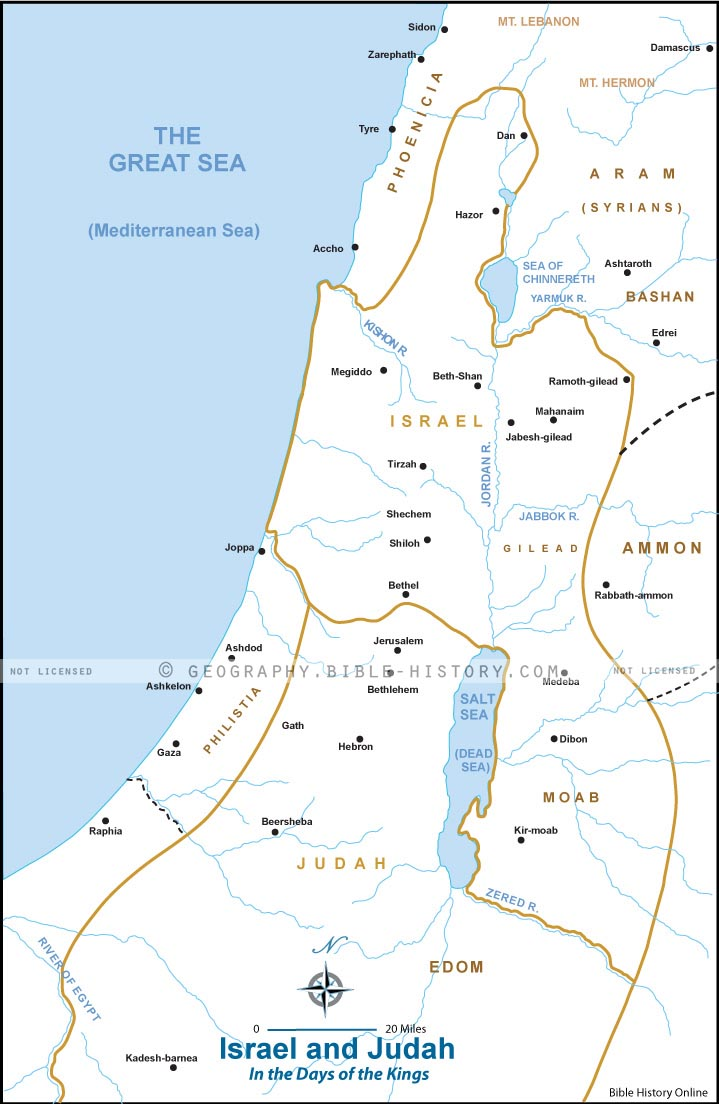Isaiah Images and
NotesThe Book of Isaiah
Isaiah
6:1-3 - In the year that king Uzziah died I saw also the
Lord sitting upon a throne, high and lifted up, and his train
filled the temple. Above it stood the seraphims: each one had
six wings; with twain he covered his face, and with twain he
covered his feet, and with twain he did fly. And one cried unto
another, and said, Holy, holy, holy, [is] the LORD of hosts: the
whole earth [is] full of his glory.
Isaiah
9:1-7 - Nevertheless the dimness [shall] not [be] such as
[was] in her vexation, when at the first he lightly afflicted
the land of Zebulun and the land of Naphtali, and afterward did
more grievously afflict [her by] the way of the sea, beyond
Jordan, in Galilee of the nations. The people that walked in
darkness have seen a great light: they that dwell in the land of
the shadow of death, upon them hath the light shined. Thou hast
multiplied the nation, [and] not increased the joy: they joy
before thee according to the joy in harvest, [and] as [men]
rejoice when they divide the spoil. For thou hast broken the
yoke of his burden, and the staff of his shoulder, the rod of
his oppressor, as in the day of Midian. For every battle of the
warrior [is] with confused noise, and garments rolled in blood;
but [this] shall be with burning [and] fuel of fire. For unto us
a child is born, unto us a son is given: and the government
shall be upon his shoulder: and his name shall be called
Wonderful, Counsellor, The mighty God, The everlasting Father,
The Prince of Peace. Of the increase of [his] government and
peace [there shall be] no end, upon the throne of David, and
upon his kingdom, to order it, and to establish it with judgment
and with justice from henceforth even for ever. The zeal of the
LORD of hosts will perform this.
Isaiah
53:1-7- Who hath believed our report? and to whom is the arm
of the LORD revealed? For he shall grow up before him as a
tender plant, and as a root out of a dry ground: he hath no form
nor comeliness; and when we shall see him, [there is] no beauty
that we should desire him. He is despised and rejected of men; a
man of sorrows, and acquainted with grief: and we hid as it were
[our] faces from him; he was despised, and we esteemed him not.
Surely he hath borne our griefs, and carried our sorrows: yet we
did esteem him stricken, smitten of God, and afflicted. But he
[was] wounded for our transgressions, [he was] bruised for our
iniquities: the chastisement of our peace [was] upon him; and
with his stripes we are healed. All we like sheep have gone
astray; we have turned every one to his own way; and the LORD
hath laid on him the iniquity of us all. He was oppressed, and
he was afflicted, yet he opened not his mouth: he is brought as
a lamb to the slaughter, and as a sheep before her shearers is
dumb, so he openeth not his mouth.
The Old Testament - A Brief Overview
Bible Survey - Isaiah
Hebrew Name - Yeshayahu "Yah is salvation"
Greek Name - Esaias (Greek form of the Hebrew)
Author - Isaiah (According to Tradition)
Date - 760 BC Approximately
Theme - The kingdom of the Messiah
Types and Shadows - In Isaiah Jesus is the suffering servant
ARCHAEOLOGY
The Black Obelisk

The Black Obelisk of
Shalmaneser III. Discovered at Calah now in the British
Museum. The Obelisk stands nearly 7 feet tall and is
about 2 feet thick. On each of the 4 sides there are 5
panels with carvings of various kings bringing tribute
to king Shalmaneser III. The second panel from the top
of the obelisk reveals king Jehu of Israel bowing at the
feet of Shalmaneser of Assyria. This is the same Jehu
who is mentioned in Scripture, and this carved relief is
the only image in all history of one of the Hebrew
kings. On the panel Shalmaneser is offering a libation
to his god. The cuneiform text around the panel reads:
"The tribute of Jehu, son of Omri: I
received from him silver, gold, a golden bowl, a golden
vase with pointed bottom, golden tumblers, golden
buckets, tin, a staff for a king [and] spears."

The Jehu Panel on the Black Obelisk
Summary of The Book of Isaiah
Isaiah prophesied during
one of the worst times in the history of Israel. The Israelites
had become so corrupt God was going to remove them out of His
sight. He raised up the Assyrian army to be an unmerciful,
barbaric, ruthless, an unstoppable war machine. Their military
tactics are still applauded today by those who understand the
art of war. God called them from their distant land to come and
destroy the Jews living in the north, and take them away from
their homeland. Isaiah was living in Judah, in the city of
Jerusalem during a time when King Uzziah had died. Isaiah prophesied during the reign of King Uzziah, King Jotham,
King Ahaz, King Hezekiah, and probably King Manasseh of Judah. His prophetic
ministry lasted from about 760 BC until about 720 BC. Isaiah chapter 6 records a
powerful vision that Isaiah received of God the King on his throne, and the king
called Isaiah to prophesy to His people. This was Isaiah's call to ministry as a
prophet of God and it is interesting that it was at a time when king Uzziah had
just died. King Uzziah was faithful servant of the Lord and people felt secure
under his leadership, but when he died there was almost a panic. This is when
the Lord showed Isaiah who was really on the throne. Isaiah was terrified at the
sight of God's holiness (Isaiah 6) and when the Lord called him and asked him
who will go with this message and Isaiah said "here am I, send me."
Isaiah warned Jerusalem about her idolatry, and her foreign
alliances, but they scorned him. They did not listen to his
warnings and quickly destroy their instruments of idolatry. He
prophesied about the Assyrians who would destroy the northern
kingdom, they were also good to come to Jerusalem but God would
deliver them. But he also told them that eventually the city
will be destroyed and captured by the Babylonians, and that a
Persian ruler named Cyrus would release the Jews from captivity.
Isaiah prophesied more about the Messiah than any other book in
the Old Testament. He also described in great detail the
blessings of the future kingdom of the Messiah. His coming would
be as a lion bringing the day of God's wrath, but he would also
first come as a savior who would die for the sins of the people.
This was Isaiah's message, the humility and beauty of the
Savior. - The above text
is © Rusty Russell - Bible History Online and must be sourced
for use on a website.
"Surely He has borne our griefs and carried our
sorrows; yet we esteemed Him stricken, smitten by God, and
afflicted. But He was wounded for our transgressions, he was
bruised for our iniquities; the chastisement for our peace was
upon Him, and by His stripes we are healed. All we like sheep
have gone astray; we have turned, every one, to his own way; and
the LORD has laid on Him the iniquity of us all." Isaiah
Isaiah
53:4-6
The book of Isaiah contains the prophecies of Isaiah who was
the son of Amoz (Isaiah 1:1). Isaiah prophesied during the reign
of King Uzziah, King Jotham, King Ahaz, King Hezekiah, and
probably King Manasseh of Judah. His prophetic ministry lasted
from about 760 BC until about 720 BC. Isaiah chapter 6 records a
powerful vision that Isaiah received of God the King on his
throne, and the king called Isaiah to prophesy to His people.
This was Isaiah's call to ministry as a prophet of God and it is
interesting that it was at a time when king Uzziah had just
died. King Uzziah was faithful servant of the Lord and people
felt secure under his leadership, but when he died there was
almost a panic. This is when the Lord showed Isaiah who was
really on the throne. Isaiah was terrified at the sight of God's
holiness (Isaiah 6) and when the Lord called him and asked him
who will go with this message and Isaiah said "here am I, send
me."
The word prophet in the Hebrew means a "mouthpiece", and
Isaiah was truly the mouthpiece of God. He was entirely
dedicated to this cause even in the midst of rejection (Isaiah
6:9-13). As his ministry developed he warned the people about
various problems within the kingdom. Judah had gone through many
reforms, but had become corrupt along the way forgetting about
the great privilege of being chosen by God, and their religious
ceremonies became vain rituals. Uzziah's son Jotham succeeded
his father on the throne and try to encourage the people to
worship Yahweh, but failed to break down the high places of
idolatrous worship. After him Ahaz followed on the throne of
Judah and he was determined to bring about the heathen
idolatrous practices of the nations around him. He was rebuked
by Isaiah and chose to lead the people further into idolatry
which ultimately would bring about their ruin. Then Hezekiah
came to the throne and he was the greatest king to ever reign in
the southern kingdom of Judah. He began ruling by "removing the
high places and breaking down the pillars, and cutting down the
Asherah (2 Kings 18:4, 22). Hezekiah restored faith in Judah and
the people celebrated in Jerusalem a Passover that would be
remembered forever in history. Isaiah was respected as a prophet
of the Lord and King Hezekiah made Isaiah famous in the land and
his prophecies were encouraged. But the kingdom of Judah had not
fully recovered from their past ways. It was during the time of
Hezekiah that the northern kingdom of Israel, Judah's brothers,
were carried away into captivity in 722 BC. Judah had barely
escaped destruction by paying heavy tribute to the Assyrian
king. Later Sennacherib of Assyria sent his armies to destroy
many nations and their lands and he came to the land of Judah to
reproach the living God (2 Kings 19:16). When Hezekiah heard the
words of the king of Assyria he sought the Lord and prayed. That
night the angel of the Lord (God himself) came into the camp of
the Assyrians and slew 185,000 soldiers (2 Kings 19:35). King
Sennacherib returned back to his palace at Nineveh without his
mighty army and while he was worshiping his gods, two of his
sons slew him with the sword. Many of the details surrounding
this event have been verified historically with the discovery of
Sennacherib's Hexagonal Prism discovered among the ruins of
ancient Nineveh. It contains the war campaigns of this king and
this time period and can be seen today on display in the British
Museum in London. The Southern Kingdom of Judah had their
moments of glory during certain times after this, but it was
just a matter of time until the seeds that had been sown would
reap a harvest of destruction. Judah would come to an end and
Jerusalem and her Temple would be destroyed, which took place in
586 BC under King Nebuchadnezzar of Babylon. Isaiah had
prophesied throughout this whole time period and even spoke of
the coming kingdom of the Messiah.
There is little information about the personal life of the
Prophet Isaiah. He was married to a woman called the
"prophetess" (Isaiah 8:3), she bore him two sons (Isaiah 7:3 and
Isaiah 8:3). According to Jewish tradition Isaiah was martyred
by the wicked King Manasseh who placed him in the hollow trunk
of a carob tree and was sawn in two. many believe also that it
was Isaiah who was referred to in the book of Hebrews in the New
Testament regarding a hero of faith "sawn asunder" (Hebrews
11:37).
Was There a Deutero-Isaiah or Second Isaiah?
There have been many critics who challenged the historicity of the
Scriptures, and implied that the Bible is not the word of God. This is also true
with the book of Isaiah, critics have identified problems in the books unity and
authorship. A large number of critics make a case that Isaiah 1-39 and Isaiah
40-66 are two separate books written by two entirely different men. They refer
to the second book as "Deutero-Isaiah" or "Second Isaiah" and they speculate
that it was written during the Babylonian captivity, and the people that the
author is addressing our different than in the first book. They also maintain
that Isaiah is never mentioned as the author in the second book. but there are
too many reasons for believing that Isaiah was the author of the whole book from
Isaiah 1 through Isaiah 66. Jewish history and Jewish tradition never recognized
anything other than one book, and one author. The discovery of the Dead Sea
Scrolls identify Isaiah as one scroll, and thus one book. Judaism and
Christianity also recognize Isaiah as one book and one author. The writing style
of Isaiah is seen throughout both sections, and the people who are being
addressed would apply more to Judah went to those captive in Babylon. There is
also mention of Temple services in existence, which were not in existence what
they were captive in Babylon. For these reasons and others, and for the fact
that Jesus never recognized more than one Isaiah we must conclude that Isaiah
was the author of his one book. It is important to understand this about
the book of Isaiah because critics are always looking for something in which
they might attack the Bible, especially the book of Isaiah because there are so
many prophecies pointing to the life and ministry and even the death of the Lord
Jesus Christ.
Quick Reference Map

Map of Israel and Judah in the
Book of Kings (Click to Enlarge)
The contents of Isaiah may be outlined as follows :
Outline of the Book of Isaiah
Section 1: Isaiah 1:39
1 ) Prophecies centered around Judah and Jerusalem (Isaiah 1:1-12:6). Included in this
section are a description of the glories of the Messianic Age (Isaiah 2-4 ) and the
account of the call of Isaiah (Isaiah 6 ). In Isaiah 7-12, although Isaiah is dealing
primarily with various invasions which threaten Judah, reference is made to the
wonderful child "Immanuel" and to the glorious age when a king of the Davidic
line would institute a benevolent rule over a world without discord and wars.
2 ) Prophecies of judgment on the foreign and hostile nations of Babylon,
Philistia, Moab, Damascus, Ethiopia, Egypt, Dumah, Arabia and Tyre (Isaiah 3-23 ).
3 ) The Apocalypse of Isaiah: the judgment of God against the world's sin and
the ultimate destruction of the earth (Isaiah 24-27). Despite the dreadful
nature of the punishment which was to come, this section is marked by a note of
triumph and trust (see Isaiah 26).
4) Prophecies concerning the relations of Judah and Jerusalem to Egypt and
Assyria (Isaiah 28-33). In this section is contained a series of six messages of woe,
directed first against one and then another of the weaknesses of Judah's
national life (Isaiah 28:1-29; 29:1-14; 29:15-24; 30:1-17; 31:1- 32 : 20; 33 : 1-24).
The character of the Messianic Age is also further described (Isaiah 32:1-18).
5 ) The doom of Edom and the redemption of Israel (Isaiah 34-35). Isaiah 35 is a beautiful
picture of the ultimate triumph of the spiritual Zion.
6 ) The reign of Hezekiah (Isaiah 36-39 ). This section is in the nature of an
historical appendix recording the overthrow of the Assyrian army (Isaiah 36- 37),
Hezekiah's sickness and recovery (Isaiah 38), and containing a prophecy of the
Babylonian captivity (Isaiah 39 ).
Section II: Isaiah 40-66
7 ) God's sovereign and providential control over history, which will be
manifest in his ultimate overthrow of Babylon at the hands of Cyrus (Isaiah 40:18). Two
passages of especial interest in this section are the first "suffering servant"
passage, apparently alluding to the office of the Messiah (Isaiah 42:1-9), and Isaiah's
sarcastic appraisal of the folly of idol worship (Isaiah 44:6-23).
8 ) The redemption which is possible through suffering and sacrifice (Isaiah 49-55)..
This division centers mainly around the three "suffering servant" passages which
it contains The first is concerned with the difficulty of his task and his
rejection by those to whom he is sent (Isaiah 44:1-13). The second (Isaiah 50:4-9) speaks of
the obedience and trust of the "servant" and the blessings which are to follow
his work. The third is the classic passage from Isaiah 52:13-53:12, which describes
the life, suffering and ultimate triumph of the servant.
9 ) The triumph of the kingdom of God and God's universal reign (Isaiah 56-66). The
sins which are prevalent in Isaiah's day are discussed in chs. 56-59. A glorious
song of the Messianic Age fills Isaiah 60-62. The book closes, with a prayer for
mercy and pardon (Isaiah 63-64) and God's answer to this prayer in the form of the
promise of a new heaven and a new earth (Isaiah 65-66).
Quick Reference Maps -
Isaiah
Judah During the Time of Hezekiah
The New Babylonian Empire and Isaiah
Sites and Events in 2 Kings
Israel and Judah - The kingdoms of Israel and Judah during
the period of the kings can be seen on this map. After Solomon
had died there was a civil war and 10 tribes took to the north
and were called the northern kingdom of Israel, and every king
was evil and forsook the LORD. The remaining 2 tribes stayed in
the south and were called the southern kingdom of Judah, several
of those kings trusted in the LORD.
Mesha's Kingdom - The Bible reveals that Mesha, the king of
Moab rebelled against Jehoram the king of Israel (2 Kings
3:4-5). Jehoram requested the help of Judah and Jehoshaphat
allied with him, he sought Elisha the prophet and victory was
predicted, only because of the faith of Jehoshaphat. Mesha
sought the god Chemosh and sacrificed his own son (2 Kings
3:27).
Israel and Syria Naaman the leper, captain of the Syrian
army was healed by a miracle at the command of Elisha the
prophet (2 Kings 5). At that time Aram (Syria) was a dominant
fighting machine in the north under the leadership of Ben-Hadad,
who was later murdered by Hazael (2 Kings 8:15).
Syria at Its Height - 2 Kings 10 reveals that Hazael of
Syria smote all the coasts of Israel and the east Jordan
territory expanding the kingdom of Damascus. Jehu knew that he
would need to rely on a foreign power for help and he turned to
Shalmanessar IV, King of Assyria.
The Kingdom of Jeroboam II - 2 Kings 14:25 indicates that
Jeroboam II, fourth king from the line of Jehu, brought the
northern kingdom of Israel to its greatest extent in the north.
This was just after Syria was severely crushed by the Assyrians
who had recently returned home to regroup.
Habor, the River of Gozan - In 2 Kings 17:6 the Bible says
that the King of Assyria (Sargon II) conquered Samaria and took
away the remaining inhabitants of Israel as prisoners to
Assyria, and placed them in Halah and in Habor by the river of
Gorzan, and in the cities of the Medes. The river of Gorzan is
identified as the river Khabur, a tributary of the Euphrates
river which flows into it from the north from southern Turkey.
The Cities of Samaria and the Surrounding Lands - The Bible
records in second Kings 17:24 that the King of Assyria (Sargon
II) brought colonists from many of the cities within the
Assyrian Empire: Babylon, Cuthah, Ava, Hamath, and from
Sepharvaim, and placed the inhabitants within the cities of
Samaria to replace the children of Israel who would been taken
into captivity.
The Assyrian Empire When Sennacherib Came to Power - Israel
was destroyed, Judah was left and Hezekiah a man who sought the
LORD had come to power in 720 BC. He offered tribute to
Sennacherib but Jerusalem was was still a target for the
Assyrian ruler.
The Assyrian Empire During the Reign of Esarhaddon -
Esarhaddon marches into Egypt and extends the Assyrian Empire. 2
Kings 19
Necho Battles Josiah - Pharaoh Necho on his way to the
Euphrates slays King Josiah at Megiddo. 2 Kings 23
The Captivity of the Ten Tribes - The ten tribes in the
northern kingdom of Israel were conquered by the Assyrians in
722 BC and taken to the land of Assyria as captives.
Judah Captives in Babylon - The remaining remnant of Judah
were taken as prisoners to Babylon as predicted by Jeremiah the
prophet.
The Babylonian, Mede and Persian Empires - Pharaoh Necho is
defeated by Nebuchadnezzar II of Babylon who also destroyed
Jerusalem in 586 BC. Later the Mede and Persian Empires defeated
Babylon and governed the world in the sixth century BC until
Alexander the Great.

Isaiah Resources
The Divided Kingdom
The
Northern Kingdom of Israel
The
Southern Kingdom of Judah
The Assyrian Captivity
The Babylonian Captivity
The Return From Babylon
The Prophets
The Messiah
The Book of Isaiah
More About the Book of
Isaiah
Isaiah in the Picture
Study Bible
Timeline of the Ancient
World
Back to the Old Testament
Back to Bible
History Online









